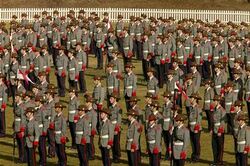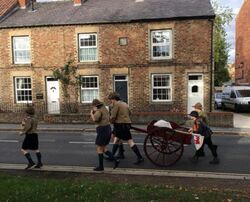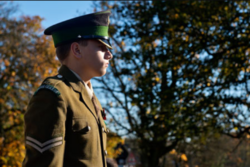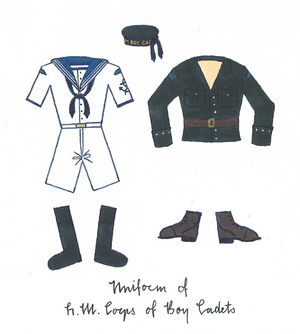King's Cadet Corps: Difference between revisions
No edit summary |
|||
| Line 51: | Line 51: | ||
Instruction is undertaken by both adult instructors as well as senior cadets. Cadet non-commissioned officers are tasked with the instruction and care of their subordinates. Retired as well as active and reserve servicemen also undertake roles as instructors. Otherwise, cadet staff officers also are expected to instruct their subordinates. | Instruction is undertaken by both adult instructors as well as senior cadets. Cadet non-commissioned officers are tasked with the instruction and care of their subordinates. Retired as well as active and reserve servicemen also undertake roles as instructors. Otherwise, cadet staff officers also are expected to instruct their subordinates. | ||
Cadets participate in physical training in regular marches, rowing voyages, assault courses, sports and games. Cadet companies often organise weekends or weeks away in the countryside for instruction and practice, army cadets marching and sea cadets rowing. Each cadet company is expected to run at least one annual week-long field exercise. Sea cadet companies alternatively often go on coastal voyages around the country. Some cadet companies, mainly those in the richer common schools, go abroad on exercises. | Cadets participate in physical training in regular marches, rowing voyages, assault courses, athletics, sports and games. Cadet companies often organise weekends or weeks away in the countryside for instruction and practice, army cadets marching and sea cadets rowing. Each cadet company is expected to run at least one annual week-long field exercise. Sea cadet companies alternatively often go on coastal voyages around the country. Some cadet companies, mainly those in the richer common schools, go abroad on exercises. | ||
On a more frequent level, cadet companies usually have weekly parade nights. Bivouacs over week-ends every [[Civil year of Great Nortend|term]] are also common. Formal parades are conducted throughout the year, especially on Whitsunday, Remembrance Day and on St George's Day (the patron saint of soldiers). Additionally, most companies hold mess dinner at least annually where mess dress is worn. | On a more frequent level, cadet companies usually have weekly parade nights. Bivouacs over week-ends every [[Civil year of Great Nortend|term]] are also common. Formal parades are conducted throughout the year, especially on Whitsunday, Remembrance Day and on St George's Day (the patron saint of soldiers). Additionally, most companies hold mess dinner at least annually where mess dress is worn. | ||
Revision as of 14:03, 12 March 2020
King's Cadet Corps | |
 Badge of the Cadet Corps | |
| Motto | Honore pro Dei et patria |
|---|---|
| Formation | June 5, 1876 |
| Type | Patriotic youth organisation |
| Headquarters | Lendert-with-Cadell, |
Membership | 550,888 |
Captain-General and Admiral | Alexander II |
Master of Cadets | Maj. Gen. Sir Stephen Daldey |
His Majesty's Corps of Boy Cadets, commonly known as the King's Cadet Corps, is a military and patriotic youth organisation operating in Great Nortend. The Corps is run by the Board of Education and the War Office in conjunction with the Home Service, Royal Army, the Navy Royal, the Royal Servicemen's Club and the Erbonian Navy League.
It developed from 19th century volunteer companies raised in Erbonian independent schools as preparation for commission into the armed forces, with the support of the War Office. In the 20th century, the Board of Education raised companies into state senior schools for boys. In 1953, for the Golden Jubilee of Edmund IX, the Corps was formally established by Royal Charter, combining the Cadet Training Force and the Sea Cadet Corps. Successive monarchs since have served as Captain-General of Cadets.
As of the start of 2019, there are 550,888 boys between the ages of 11 and 19 in the Corps.
Objects, motto and emblem
The objective of the Corps, as stated in its Royal Charter, is to promote, “The advancement of Christian manliness, courage, discipline, reverence and self-respect, and to nurture patriotism and allegiance to God, King and Country amongst the Boys of the Realm”.
The motto, Honore pro Dei et patria, is Latin for 'By honour for God and country', was chosen by Richard Errol, the then Colonel of Cadets and first Master of Cadets in 1953. The emblem of the Corps depicts the crossed swords of the Royal Army and Navy Royal encircled in a band bearing the motto, surmounted by the royal crown.
Organisation
The Cadet Corps is divided into the Army Cadets and Sea Cadets, with support from the Royal Army and Navy Royal respectively.
The Cadet Corps operate locally within a regional and national hierarchy. Cadet units are commanded by adult officers, assisted by senior cadets. Officers of the Cadet Corps are commissioned officers in the Home Service or Home Fleet. Local units of Army Cadets are raised as Companies whilst local units of Sea Cadets are known as [ships'] companies although titled Training Ships.
The majority of units operate out of senior schools. Sea companies are limited to schools located in coastal regions and on the lower reaches of major rivers. Army companies are common throughout the country. A single school sometimes has both Army and Sea companies.
The Army Cadets are organised as a corps of the Royal Army and the Sea Cadets as a fleet of the Navy Royal. As such, the Sovereign holds the title of Captain-General and Admiral of the Corps whilst operational command of the entire Corps is held by the Master of Cadets, currently Maj. Gen. Sir Stephen Daldey. The position of Colonel of Cadets is held by Col. James Wegg-Wainwright and the position of Commodore of Cadets is held by Cdre. Henry Polstave. [1]
Army Cadets
Within an Army Cadet company, there are multiple platoons. A platoon is commanded by a senior Ensign cadet cadet under-officer, with (adult) Lieutenants and Captains at a company level. Colour Serjeants and Warrant Officers hold appointments within the company, such as Company Serjeant Major and Company Quartermaster Serjeant. Within a platoon, the Serjeant serves as the second-in-command with sections commanded by Corporals and Lance Corporals.
Multiple companies are grouped into battalions commanded by a Major. Each battalion operates in a particular region, usually roughly corresponding to a county, although independent and common school companies have their own battalions covering a larger area each. A Commandant is in charge of each of the three provincial brigades, and the Colonel of Cadets commands the Army Cadets as a whole.
Sea Cadets
Sea Cadet companies are organised as a ship's company with multiple divisions commanded by a senior Midshipman cadet under-officer. Within the division the second-in-command is the Petty Officer. Senior Petty Officers and Warranted Officers hold appointments within the company such as Coxswain, Boatswain or Storekeeper. Adult Lieutenants command the unit. The Officer Commanding holds the appointment of First Lieutenant.
Several companies are grouped into a squadron per region commanded by a Commander. Several squadrons make up each of the three flotillas in the Cadet Fleet, each commanded by a Captain. A Commodore commands the Sea Cadets as a whole.
Instruction and Activities
The core component to cadet activities is based on general military training. This includes learning military history, service customs and traditions, and drill. Cadets also learn the principles of navigation (both on land and at sea), field surgery, marksmanship and field-craft or seamanship. Community service, patriotism, leadership and moralisation are also important elements of cadet instruction.
Instruction is undertaken by both adult instructors as well as senior cadets. Cadet non-commissioned officers are tasked with the instruction and care of their subordinates. Retired as well as active and reserve servicemen also undertake roles as instructors. Otherwise, cadet staff officers also are expected to instruct their subordinates.
Cadets participate in physical training in regular marches, rowing voyages, assault courses, athletics, sports and games. Cadet companies often organise weekends or weeks away in the countryside for instruction and practice, army cadets marching and sea cadets rowing. Each cadet company is expected to run at least one annual week-long field exercise. Sea cadet companies alternatively often go on coastal voyages around the country. Some cadet companies, mainly those in the richer common schools, go abroad on exercises.
On a more frequent level, cadet companies usually have weekly parade nights. Bivouacs over week-ends every term are also common. Formal parades are conducted throughout the year, especially on Whitsunday, Remembrance Day and on St George's Day (the patron saint of soldiers). Additionally, most companies hold mess dinner at least annually where mess dress is worn.
Membership
Membership of the Corps is open to boys between the ages of 11 and 19. In 2019, there were 550,888 cadets in the Corps and around 20,000 adult officers. Girls may not become cadets.
The vast majority of cadets enter the Corps through their senior school although board schools allow non-pupils to become cadets. 83% of all boys' senior schools operate a cadet company and of these, membership of the Corps is compulsory in 90% in at least the First Form. 82% of all boys between the ages of 11 and 16 inclusive are active cadets.
Approximately 95% of voluntary enlistees in the Royal Army have a background as a cadet NCO. The connexions developed between cadet companies and local regiments and naval bases are considered valuable for recruitment purposes.
Oath
Joining the Corps requires that prospective members take the Oath of Engagement in the form prescribed:
I, A. B., do swear that I will be faithful and bear true liegeance unto our Sovereign Lord, Alexander the Second, his heirs and successors, as a cadet in His Majesty's Corps of Boy Cadets, according to law. So help me God.
Ranks
The Corps uses a system of rank analogous to those of the Royal Army and Navy Royal
Cadet Ensigns and Midshipmen receive formal warrants from the War Office entitling them to be saluted by lower ranking cadets. They are, however, not saluted by actual members of the Royal Army or Navy Royal except when returning a salute. Cadet Warranted Officers also receive warrants, but they are not thereby entitled to salutes.
Adult cadet Staff Officers are regularly commissioned officers of the Home Service and Home Fleet respectively, and thus are saluted in the normal fashion. Permanent adult instructors are drawn from cadet Staff Officers and Home Service or Home Fleet NCOs. Rarely will civilians serve as instructors, and in such cases, they hold a nominal rank of Serjeant, Staff Serjeant, Petty Officer or Senior Petty Officer.
Uniforms
The undress uniform of the Army Cadets is based on the general service duty dress of the Royal Army. It includes a khaki shirt with black necktie. This is worn with grey shorts and knee-socks in summer and grey trousers and gaiters in winter, with the black leather belt. A dark khaki-brown tunic may be worn over the shirt in winter and cold weather. A grey beret, bonnet, pillbox or forage cap is worn. Royal blue shoulder patches are sewn onto uniform shirts and coats with the words 'Cadet Corps' embroidered in white.
Sea Cadets of the Cadet Corps wear a uniform based on the duty dress of the Navy Royal. This comprises a white flannel shirt, a blue jean collar and black neckerchief, with white shorts and navy knee-socks in summer and navy trousers and white gaiters in winter with a white belt. A navy jacket may be worn over the shirt and under the collar in winter and cold weather. A navy sailor's cap or sennit hat is worn. As for the normal uniform, royal blue shoulder patches are worn.
Cadets must wear the uniform of the Corps in accordance with the Corps uniform regulations. It must not be worn in conjunction with civilian items of clothing, and must be worn at all times at cadet events and activities, unless explicitly dispensed with.
Staff officers wear their Home Service or Home Fleet uniforms with the cadet shoulder patches.
Dress uniforms
Senior cadets and officers are scaled to receive Dress Order II for day formal occasions as well as mess dress. Individual companies may purchase additional uniform items for junior cadets.
This page is written in Erbonian English, which has its own spelling conventions (colour, travelled, centre, realise, instal, sobre, shew, artefact), and some terms that are used in it may be different or absent from other varieties of English. |
- ↑ By comparison, a regiment is headed by an honorary Colonel of the Regiment and commanded by a Commandant. A corps is headed by a Captain-General and commanded by a Colonel.







